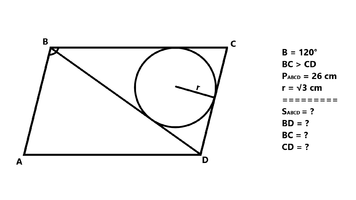politexnik
New member
- Joined
- Jun 28, 2023
- Messages
- 7
View attachment 36135
Good afternoon, please help, I’ll also say that you need to solve it normally without inserted numbers that will fit.

Looking through your "history" in the forum, I note that you always post your problem(s) unaccompanied by any initial attempts to solve them (or identification of where exactly your difficulty lies) or any thoughts you may have on an approach to solving them, you never post any final solutions you have reached on the problems after help has been given (despite this having been requested of you more than once) and you are not good at responding to requests made of you in general! ?Good afternoon, please help, I’ll also say that you need to solve it normally without inserted numbers that will fit.
I have seen S used to mean area (either Surface Area, or some word in another language), so that is another possibility.PABCD = The Perimeter of ABCD (= 26 cm) and, if SABCD is the Semiperimeter of ABCD, then SABCD = 13 cm. Yes?
(Is it possible that SABCD should have been SBCD, ie: the Semiperimeter of ΔBCD?)
I can tell you that I have solved it, and the first step was to find CF on @The Highlander's marked up drawing, which you should find very helpful.View attachment 36135
Good afternoon, please help, I’ll also say that you need to solve it normally without inserted numbers that will fit.
Agreed! (Absolutement!)I can tell you that I have solved it, and the first step was to find CF on @The Highlander's marked up drawing, which you should find very helpful.
But I see you have been given a solution on another site, so the polite thing to do (presumably unrelated to your name) would be to tell us that you don't need any more help (and to stop posting here, since it clearly is not help that you want).
If you recall my suggestion (post #5) that SABCD might mean area, as I've seen in some questions in the past, you can see why they might have asked for that! It's just twice what you've calculated, which is central to the process of finding the other quantities (though BD came first). So that may have been a little hint.So we may now calculate the Area of the triangle BCD as...
A = sr = 10√3
You meant (b - 8)(b - 5) = 0, right?(b−8)(b−5)=40
and so b = 8 or 5.
Actually, on the other site it was only revealed that "BD = 7, and the rest is easy". But that was taken as a satisfactory answer, so perhaps the rest was easy to them. (I'd say finding BD is the easy part.)Furthermore, @Dr.Peterson has pointed out that the OP obtained a solution to the problem on another site (or sites) so I think it's only fair that a solution should also be present here (for interested observers).
Indeed but I just used S to mean Semiperimeter because it suited my purposes. ?If you recall my suggestion (post #5) that SABCD might mean area, as I've seen in some questions in the past, you can see why they might have asked for that! It's just twice what you've calculated, which is central to the process of finding the other quantities (though BD came first). So that may have been a little hint.
Absolutely! I will request that slip-up be amended. (It was a lengthy treatise to spot every mistake in it! ?)You meant (b - 8)(b - 5) = 0, right?
I would agree completely.Actually, on the other site it was only revealed that "BD = 7, and the rest is easy". But that was taken as a satisfactory answer, so perhaps the rest was easy to them. (I'd say finding BD is the easy part.)
